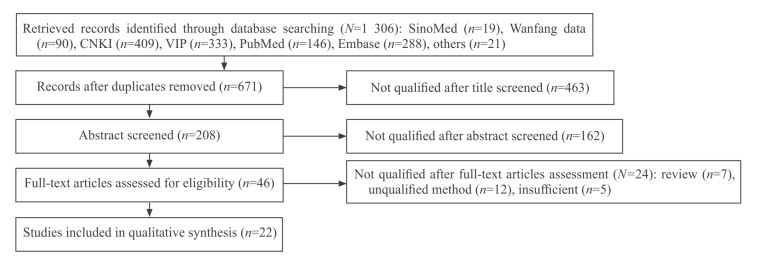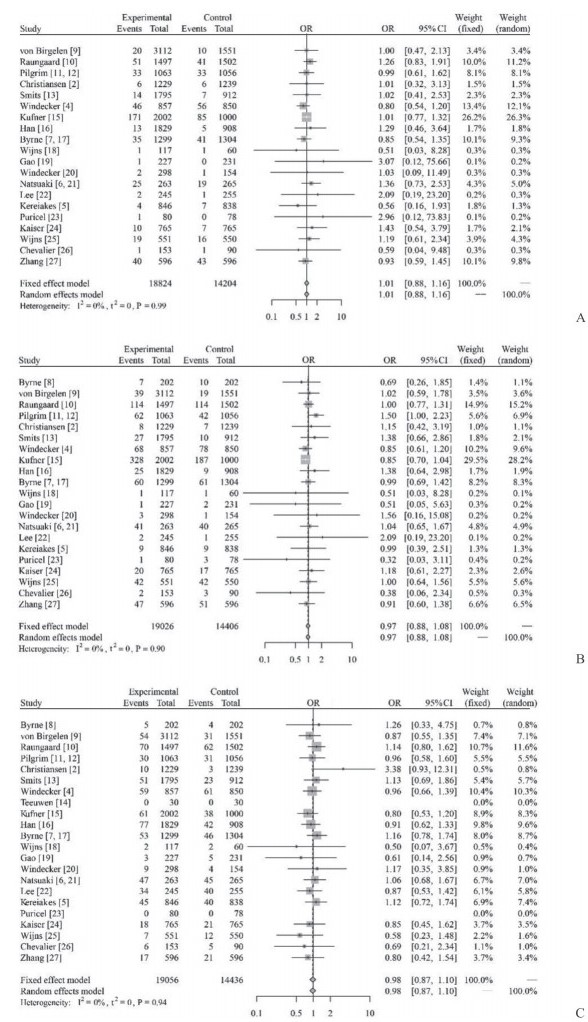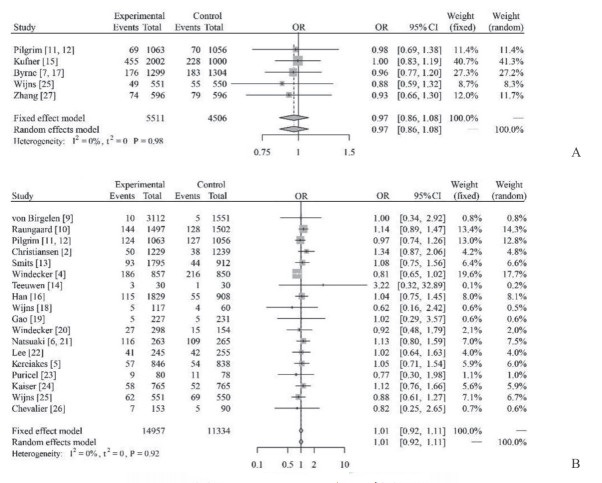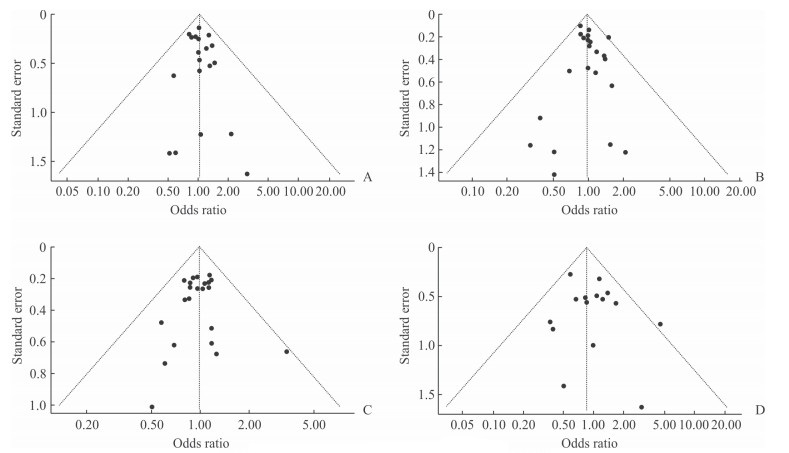近10年来由生物可降解聚合物制成的第3代药物洗脱心脏支架即生物可吸收支架被应用于冠心病的治疗中,对于其具体安全性与有效性的判断,在医疗领域众说纷纭[1]。生物可吸收支架是否有其设计的实际意义或在安全性与有效性上不低于第1代和第2代药物洗脱心脏支架即不可降解支架(以下简称为药物洗脱支架)引起了广泛争议,并在全球范围内开展了大量的临床试验研究[2-7]。
本研究收集了近些年心血管病领域有关生物可吸收支架与药物洗脱支架比较的相关临床试验研究资料,对心源性死亡率、总体死亡率、心肌梗死发生率、支架内血栓发生率、靶病变血运重建率和靶血管血运重建率等单指标以及综合指标分别进行meta分析,比较生物可吸收支架与药物洗脱支架治疗心血管疾病的安全性和有效性。
1 资料和方法 1.1 资料来源依据系统评价和meta分析优先报告的条目(preferred reporting items for systematic reviews and meta-analyses,PRISMA)标准,对公开发表的中英文文献进行计算机检索,检索数据库包括中国生物医学文献服务系统(SinoMed)、万方、中国知网(CNKI)、维普(VIP)、PubMed、Medline、Embase数据库,检索年限为1980年1月至2018年10月。中文检索采用“支架”AND(“心血管疾病”OR“冠心病”)AND(“可吸收”OR“可降解”OR“生物可降解”OR“生物可吸收”)AND(“不可吸收”OR“不可降解”OR“生物不可降解”OR“生物不可吸收”)逻辑组合,英文检索采用“stent”AND(“durable polymer”OR“durable”)AND(“biodegradable polymer” OR “biodegradable”)AND “acute coronary syndrome”逻辑组合,最初共检索到1 306篇文献,通过人工筛选,最后纳入22项研究共25篇科学引文索引(science citation index,SCI)收录的期刊文献。
1.2 文献纳入标准(1)发表于SCI收录期刊的有关心血管病治疗的生物可吸收支架与药物洗脱支架比较的文献;(2)研究方法严谨,无明显设计缺陷的文献;(3)研究方法为临床试验研究;(4)提供了所需的安全性指标人数及有效性指标人数。
1.3 文献排除标准(1)设计不合理,有明显缺陷;(2)观察性研究;(3)未提供所需数据;(4)综述类文献;(5)同一临床试验的重复研究与亚组分析。
1.4 文献质量控制由2名研究者独立进行文献筛选,意见不同时征求第三方的意见。数据由2人提取,共同校对。采用Jadad量表对文献质量进行评价[5]。Jadad量表主要从临床试验盲法的使用、随机化数字的产生、随机的隐藏以及对失访和脱落的处理4个维度对文献质量进行评价,评分结果1~3分表示低质量文献,4~7分表示高质量文献。
1.5 研究指标选定综合文献报道与临床专家意见,对心源性死亡率、总体死亡率、心肌梗死发生率和支架内血栓发生率等安全性指标和靶病变血运重建率、靶血管血运重建率等有效性指标进行合并分析,选择主要心脏不良事件作为综合性指标进行合并分析。
1.6 统计学处理应用R 3.5.1软件meta程序包和metafor程序包进行系统分析,得出各指标的合并比值比(odds ratio,OR)、95%置信区间(confidence interval,CI)和P值,当差异性检验P<0.05时,认为两种支架差异有统计学意义。本研究采用χ2检验及I2指数检验异质性,若P≥0.10且I2≤50%时,表明无异质性,采用固定效应模型;若P<0.10或I2>50%,表明存在异质性,采用随机效应模型。使用漏斗图观察发表偏倚,漏斗图呈中心对称表明发表偏倚较小。通过每次删除1个研究来检验敏感性,未发生明显改变则证明研究结果较稳定。
2 结果 2.1 纳入研究与指标定义经过严格筛选,最终纳入22项研究进行meta分析,均为临床试验研究结果且独立不重复,对于同一临床试验结果的报道则选用随访时间更长的文献,临床试验均通过随机化及纳入、排除标准严格地控制了混杂因素,使两种支架的比较结果具有更高的临床证据等级。22项研究合计纳入33 570名研究对象,其中19 056名研究对象使用生物可吸收支架、14 514名使用药物洗脱支架,研究随访时长为9~60个月。洗脱药物共有5种,分别为西罗莫司(sirolimus)、依维莫司(everolimus)、佐他莫司(zotarolimus)、biolimus、紫杉醇(paclitaxel)。筛选流程见图 1,纳入研究特征与具体洗脱药物种类见表 1。

|
图 1 文献筛选流程图 Fig 1 Flow diagram of literature screening |
|
|
表 1 纳入研究特征 Tab 1 Characteristics of included studies |
本次研究指标总体死亡率的统计包含所有原因引起的死亡,心肌梗死发生率的统计包含与靶向血管相关的心肌梗死。早期支架内血栓为术后30 d内发生的支架内血栓,晚期支架内血栓为术后30 d后发生的支架内血栓。靶病变血运重建指对目标病变部位的血管进行血运重建术。靶血管血运重建指支架置入后无法使血管保持通畅,仍需对心血管进行血运重建术,但不限于目标病变部位。主要心脏不良事件有两种定义方式:一是个体发生心源性死亡、心肌梗死或靶病变血运重建中的任何一个事件,二是指心源性死亡、心肌梗死或靶血管血运重建[28]。有关心脏支架置入研究的文献中对此有不同的定义或均进行报道,因此本研究将二者均纳入分析。
2.2 文献质量评价采用Jadad量表评分,根据4个评价项目,所有文献评分均≥5分(表 1),表明文献质量总体较好。
2.3 Meta分析结果 2.3.1 安全性指标(心源性死亡率、总体死亡率、心肌梗死发生率)分析合并分析结果表明,生物可吸收支架相对于药物洗脱支架,心源性死亡率、总体死亡率以及心肌梗死发生率的差异均无统计学意义,且各项指标点估计值均接近1。其中心源性死亡率的合并OR(95% CI)为1.01(0.88,1.16),P=0.878;总体死亡率的合并OR(95% CI)为0.97(0.88,1.08),P=0.627;心肌梗死发生率的合并OR(95% CI)为0.98(0.87,1.10),P=0.745。因此不能认为两种支架在安全性上存在差异。安全性指标合并森林图见图 2。

|
图 2 安全性指标合并森林图 Fig 2 Forest plots of clinical safety rate A: Cardiac death; B: All-caused death; C: Myocardial infarction. Experimental: The bioabsorbable stents; Control: The drug-eluting stents. OR: Odds ratio; CI: Confidence interval |
2.3.2 有效性指标分析
合并分析结果表明,生物可吸收支架相对于药物洗脱支架,靶病变血运重建率与靶血管血运重建率的差异均无统计学意义。其中靶病变血运重建率的合并OR(95% CI)为0.99(0.89,1.09),P=0.786;靶血管血运重建率的合并OR(95% CI)为1.03(0.95,1.13),P=0.593。因此不能认为两种支架在有效性上存在差异。
2.3.3 综合性指标分析合并分析结果表明,生物可吸收支架相对于药物洗脱支架在“心源性死亡+心肌梗死+靶病变血运重建”主要心脏不良事件发生率与“心源性死亡+心肌梗死+靶血管血运重建”主要心脏不良事件发生率这2个综合性指标比较上,合并OR(95% CI)分别为0.97(0.86,1.08)和1.01(0.92,1.11),差异均无统计学意义(P=0.556,P=0.891),因此不能认为两种支架在综合疗效上存在差异。综合性指标合并森林图见图 3。

|
图 3 综合性指标合并森林图 Fig 3 Forest plots of composite indicator rate A: Cardiac death+myocardial infarction+target lesion revascularization; B: Cardiac death+myocardial infarction+target vessel revascularization. Experimental: The bioabsorbable stents; Control: The drug-eluting stents. OR: Odds ratio; CI: Confidence interval |
2.3.4 安全性指标(支架内血栓发生率)分析
合并分析结果表明,生物可吸收支架相对于药物洗脱支架,在临床确诊的支架内血栓发生率的比较中差异无统计学意义[OR(95% CI)为0.84(0.63,1.11),P=0.217]。而在临床确诊或疑似的支架内血栓的比较中,生物可吸收支架的支架内血栓发生率低于药物洗脱支架,差异有统计学意义[OR(95% CI)为0.80(0.65,0.99),P=0.042]。进一步探究不同时期的临床确诊或疑似的支架内血栓发生率,通过比较发现两种支架的早期支架内血栓发生率差异无统计学意义[OR(95% CI)为0.97(0.69,1.37),P=0.906];但在晚期,即术后>30 d的随访中,生物可吸收支架的支架内血栓发生率低于药物洗脱支架,差异有统计学意义[OR(95% CI)为0.61(0.43,0.86),P=0.004]。支架内血栓发生率指标合并森林图见图 4。

|
图 4 支架内血栓发生率合并森林图 Fig 4 Forest plots of stent thrombus incidence A: Definite stent thrombus; B: Definite/probability stent thrombus; C: Early stent thrombus; D: Late stent thrombus. Experimental: The bioabsorbable stents; Control: The drug-eluting stents. OR: Odds ratio; CI: Confidence interval |
2.4 发表偏倚分析与敏感性分析
选用漏斗图对各指标的发表偏倚进行检验,所有安全性指标与有效性指标所对应的漏斗图均呈中心对称,发表偏倚较小。见图 5(由于篇幅有限,未提供所有的漏斗图)。对各指标分别进行敏感性分析,每次剔除1个研究后结果均未发生明显变化,故认为每项合并指标研究的稳定性较好。

|
图 5 发表偏倚漏斗图 Fig 5 Funnel plots of publication bias A: Cardiac death; B: All-caused death; C: Myocardial infarction; D: Definite stent thrombus |
3 讨论
随着心脏支架的发展和广泛使用,不同的材料或洗脱药物被应用于支架的制造。近年生物可降解吸收材料被大量应用于支架的设计与改进,并广泛地进入医药市场。生物可吸收支架在置入后6~9个月可被生物体降解吸收,被认为是解决药物洗脱支架长期置入易造成血管内皮损伤从而引发支架内血栓的有效解决方案。在此前的meta分析中发现,生物可吸收支架相对于药物洗脱支架在疗效方面差异无统计学意义,但能有效减少支架内血栓的发生率[29-30]。但也有meta分析未发现生物可吸收支架对支架内血栓发生有保护作用[28, 31]。
本研究结合安全性与有效性两个方面对生物可吸收支架和药物洗脱支架的效果进行评价,并引入临床试验中广泛应用的综合性指标,使疗效评价更具有科学性。对于支架内血栓,本研究对临床确诊与疑似支架内血栓两种情况分开进行了分析,再对临床确诊与疑似支架内血栓以30 d为界进行早、晚期的细分。本研究通过合并分析发现,在安全性指标(心源性死亡率、总体死亡率、心肌梗死发生率)、有效性指标(靶病变血运重建率和靶血管血运重建率)以及综合性评价指标(“心源性死亡+心肌梗死+靶病变血运重建”主要心脏不良事件发生率和“心源性死亡+心肌梗死+靶血管血运重建”主要心脏不良事件发生率)的比较中,不能认为生物可吸收支架的疗效更好于药物洗脱支架。而在晚期的支架内血栓发生率的研究中发现,使用生物可吸收支架,可以降低支架内血栓的发生风险。在对晚期的支架内血栓发生率进一步的研究中发现,两种支架的血栓发生具体差异更体现在支架置入1年后的发生率,在BIOSCIENCE和BIOFLOWⅡ 2项临床试验的5年报告中,发现两种支架的1~5年支架内血栓发生率差异极大,但由于多数临床试验尚未完成5年随访,可纳入的文献较少,因此本研究未将1年后的情况分开进行研究。综合以上结果,本研究认为生物可吸收支架有其继续被研究和应用的意义。
本研究纳入的文献多数来源于Lancet、JACC Cardiovasc Interv、EuroIntervention和Circ Cardiovasc Interv等具有较高影响因子的心脏疾病杂志,研究类型均为大型心脏支架多中心临床试验,且所有临床试验依从性好,随访因主观意愿脱落病例均少于5%。而且本研究纳入的研究数据量大,22项研究共计33 570名研究对象,说服性较好,表明本研究结果具有较强的临床意义。但本研究仍有许多不足之处,一是未对同一研究的长短期试验结果进行记录并分别进行系统分析;二是未对其他相关因素如肥胖、性别、洗脱药物种类等进行亚组分析,今后我们将改进不足,完善研究。
| [1] |
LV J, WU Y, ZHANG X, JING T, ZHANG L, TONG S, et al. Comparison of the safety and efficacy of biodegradable polymer drug-eluting stents versus durable polymer drug-eluting stents: a meta-analysis[J/OL]. Eur J Med Res, 2015, 20: 21. doi: 10.1186/s40001-015-0110-z.
|
| [2] |
CHRISTIANSEN E H, JENSEN L O, THAYSSEN P, TILSTED H H, KRUSELL L R, HANSEN K N, et al. Biolimus-eluting biodegradable polymer-coated stent versus durable polymer-coated sirolimus-eluting stent in unselected patients receiving percutaneous coronary intervention (SORT OUT Ⅴ):a randomised non-inferiority trial[J]. Lancet, 2013, 381: 661-669. DOI:10.1016/S0140-6736(12)61962-X |
| [3] |
BUSZMAN P P, ORLIK B, TRELA B, MILEWSKI K, KOZLOWSKI M, PRUSKI M J, et al. Comparable clinical safety and efficacy of biodegradable versus durable polymer paclitaxel eluting stents despite shorter dual antiplatelet therapy: insights from a multicenter, propensity score-matched registry[J/OL]. Catheter Cardiovasc Interv, 2013, 82: E155-E162. doi: 10.1002/ccd.24732.
|
| [4] |
WINDECKER S, SERRUYS P W, WANDEL S, BUSZMAN P, TRZNADEL S, LINKE A, et al. Biolimus-eluting stent with biodegradable polymer versus sirolimus-eluting stent with durable polymer for coronary revascularisation (LEADERS):a randomised non-inferiority trial[J]. Lancet, 2008, 372: 1163-1173. DOI:10.1016/S0140-6736(08)61244-1 |
| [5] |
KEREIAKES D J, MEREDITH I T, WINDECKER S, LEE JOBE R, MEHTA S R, SAREMBOCK I J, et al. Efficacy and safety of a novel bioabsorbable polymer-coated, everolimus-eluting coronary stent: the EVOLVE Ⅱ Randomized Trial[J/OL]. Circ Cardiovasc Interv, 2015, 8. pii: e002372. doi: 10.1161/CIRCINTERVENTIONS.114.002372.
|
| [6] |
NATSUAKI M, KOZUMA K, MORIMOTO T, KADOTA K, MURAMATSU T, NAKAGAWA Y, et al. Five-year outcome of a randomised trial comparing second-generation drug-eluting stents using either biodegradable polymer or durable polymer:the NOBORI biolimus-eluting versus XIENCE/PROMUS everolimus-eluting stent trial (NEXT)[J]. EuroIntervention, 2018, 14: 815-818. DOI:10.4244/EIJ-D-17-01050 |
| [7] |
BYRNE R A, KASTRATI A, MASSBERG S, WIECZOREK A, LAUGWITZ K L, HADAMITZKY M, et al. Biodegradable polymer versus permanent polymer drug-eluting stents and everolimus versus sirolimus-eluting stents in patients with coronary artery disease:3-year outcomes from a randomized clinical trial[J]. J Am Coll Cardiol, 2011, 58: 1325-1331. DOI:10.1016/j.jacc.2011.06.027 |
| [8] |
BYRNE R A, KUFNER S, TIROCH K, MASSBERG S, LAUGWITZ K L, BIRKMEIER A, et al. Randomised trial of three rapamycin-eluting stents with different coating strategies for the reduction of coronary restenosis:2-year follow-up results[J]. Heart, 2009, 95: 1489-1494. DOI:10.1136/hrt.2009.172379 |
| [9] |
VON BIRGELEN C, KOK M M, VAN DER HEIJDEN L C, DANSE P W, SCHOTBORGH C E, SCHOLTE M, et al. Very thin strut biodegradable polymer everolimus-eluting and sirolimus-eluting stents versus durable polymer zotarolimus-eluting stents in allcomers with coronary artery disease (BIO-RESORT):a three-arm, randomised, non-inferiority trial[J]. Lancet, 2016, 388: 2607-2617. DOI:10.1016/S0140-6736(16)31920-1 |
| [10] |
RAUNGAARD B, JENSEN L O, TILSTED H H, CHRISTIANSEN E H, MAENG M, TERKELSEN C J, et al. Zotarolimus-eluting durable-polymer-coated stent versus a biolimus-eluting biodegradable-polymer-coated stent in unselected patients undergoing percutaneous coronary intervention (SORT OUT Ⅵ):a randomised non-inferiority trial[J]. Lancet, 2015, 385: 1527-1535. DOI:10.1016/S0140-6736(14)61794-3 |
| [11] |
PILGRIM T, PICCOLO R, HEG D, ROFFI M, TULLER D, MULLER O, et al. Ultrathin-strut, biodegradable-polymer, sirolimus-eluting stents versus thin-strut, durable-polymer, everolimus-eluting stents for percutaneous coronary revascularisation:5-year outcomes of the BIOSCIENCE randomised trial[J]. Lancet, 2018, 392: 737-746. DOI:10.1016/S0140-6736(18)31715-X |
| [12] |
PILGRIM T, PICCOLO R, HEG D, ROFFI M, TULLER D, VUILLIOMENET A, et al. Biodegradable polymer sirolimus-eluting stents versus durable polymer everolimus-eluting stents for primary percutaneous coronary revascularisation of acute myocardial infarction[J/OL]. EuroIntervention, 2016, 12: e1343-e1354. doi: 10.4244/EIJY15M12_09.
|
| [13] |
SMITS P C, HOFMA S, TOGNI M, VAZQUEZ N, VALDES M, VOUDRIS V, et al. Abluminal biodegradable polymer biolimus-eluting stent versus durable polymer everolimus-eluting stent (COMPARE Ⅱ):a randomised, controlled, non-inferiority trial[J]. Lancet, 2013, 381: 651-660. DOI:10.1016/S0140-6736(12)61852-2 |
| [14] |
TEEUWEN K, SPOORMANS E M, BENNETT J, DUBOIS C, DESMET W, UGHI G J, et al. Optical coherence tomography findings: insights from the "randomised multicentre trial investigating angiographic outcomes of hybrid sirolimus-eluting stents with biodegradable polymer compared with everolimus-eluting stents with durable polymer in chronic total occlusions" (PRISON Ⅳ) trial[J/OL]. EuroIntervention, 2017, 13: e522-e530. doi: 10.4244/EIJ-D-17-00261.
|
| [15] |
KUFNER S, SORGES J, MEHILLI J, CASSESE S, REPP J, WIEBE J, et al. Randomized trial of polymer-free sirolimus- and probucol-eluting stents versus durable polymer zotarolimus-eluting stents:5-year results of the ISAR-TEST-5 trial[J]. JACC Cardiovasc Interv, 2016, 9: 784-792. DOI:10.1016/j.jcin.2016.01.009 |
| [16] |
HAN Y, XU B, JING Q, LU S, YANG L, XU K, et al. A randomized comparison of novel biodegradable polymer- and durable polymer-coated cobalt-chromium sirolimus-eluting stents[J]. JACC Cardiovasc Interv, 2014, 7: 1352-1360. DOI:10.1016/j.jcin.2014.09.001 |
| [17] |
BYRNE R A, KASTRATI A, KUFNER S, MASSBERG S, BIRKMEIER K A, LAUGWITZ K L, et al. Randomized, non-inferiority trial of three limus agent-eluting stents with different polymer coatings:the Intracoronary Stenting and Angiographic Results:Test Efficacy of 3 Limus-Eluting Stents (ISAR-TEST-4) Trial[J]. Eur Heart J, 2009, 30: 2441-2449. DOI:10.1093/eurheartj/ehp352 |
| [18] |
WIJNS W, VROLIX M, VERHEYE S, SCHOORS D, SLAGBOOM T, GOSSELINK M, et al. Randomised study of a bioabsorbable polymer-coated sirolimus-eluting stent:results of the DESSOLVE Ⅱ trial[J]. EuroIntervention, 2015, 10: 1383-1390. DOI:10.4244/EIJY14M05_03 |
| [19] |
GAO R L, XU B, LANSKY A J, YANG Y J, MA C S, HAN Y L, et al. A randomised comparison of a novel abluminal groove-filled biodegradable polymer sirolimus-eluting stent with a durable polymer everolimus-eluting stent:clinical and angiographic follow-up of the TARGET Ⅰ trial[J]. EuroIntervention, 2013, 9: 75-83. DOI:10.4244/EIJV9I1A12 |
| [20] |
WINDECKER S, HAUDE M, NEUMANN F J, STANGL K, WITZENBICHLER B, SLAGBOOM T, et al. Comparison of a novel biodegradable polymer sirolimus-eluting stent with a durable polymer everolimus-eluting stent: results of the randomized BIOFLOW-Ⅱ trial[J/OL]. Circ Cardiovasc Interv, 2015, 8: e001441. doi: 10.1161/CIRCINTERVENTIONS.114.001441.
|
| [21] |
NATSUAKI M, KOZUMA K, MORIMOTO T, KADOTA K, MURAMATSU T, NAKAGAWA Y, et al. Biodegradable polymer biolimus-eluting stent versus durable polymer everolimus-eluting stent:a randomized, controlled, noninferiority trial[J]. J Am Coll Cardiol, 2013, 62: 181-190. DOI:10.1016/j.jacc.2013.04.045 |
| [22] |
LEE J Y, PARK D W, KIM Y H, AHN J M, KIM W J, KANG S J, et al. Comparison of biolimus A9-eluting (Nobori) and everolimus-eluting (Promus Element) stents in patients with de novo native long coronary artery lesions:a randomized Long Drug-Eluting Stent Ⅴ trial[J]. Circ Cardiovasc Interv, 2014, 7: 322-329. DOI:10.1161/CIRCINTERVENTIONS.113.000841 |
| [23] |
PURICEL S, ARROYO D, CORPATAUX N, BAERISWYL G, LEHMANN S, KALLINIKOU Z, et al. Comparison of everolimus- and biolimus-eluting coronary stents with everolimus-eluting bioresorbable vascular scaffolds[J]. J Am Coll Cardiol, 2015, 65: 791-801. DOI:10.1016/j.jacc.2014.12.017 |
| [24] |
KAISER C, GALATIUS S, JEGER R, GILGEN N, SKOV JENSEN J, NABER C, et al. Long-term efficacy and safety of biodegradable-polymer biolimus-eluting stents:main results of the Basel Stent Kosten-Effektivitäts Trial-PROspective Validation Examination Ⅱ (BASKET-PROVE Ⅱ), a randomized, controlled noninferiority 2-year outcome trial[J]. Circulation, 2015, 131: 74-81. DOI:10.1161/CIRCULATIONAHA.114.013520 |
| [25] |
WIJNS W, VALDES-CHAVARRI M, RICHARDT G, MORENO R, ÍÑIGUEZ-ROMO A, BARBATO E, et al. Long-term clinical outcomes after bioresorbable and permanent polymer drug-eluting stent implantation: final five-year results of the CENTURY Ⅱ randomised clinical trial[J/OL]. EuroIntervention, 2018, 14: e343-e351. doi: 10.4244/EIJ-D-18-00358.
|
| [26] |
CHEVALIER B, SILBER S, PARK S, GARCIA E, SCHULER G, SURYAPRANATA H, et al. Randomized comparison of the Nobori Biolimus A9-eluting coronary stent with the Taxus Liberté paclitaxel-eluting coronary stent in patients with stenosis in native coronary arteries:the NOBORI 1 trial-phase 2[J]. Circ Cardiovasc Interv, 2009, 2: 188-195. DOI:10.1161/CIRCINTERVENTIONS.108.823443 |
| [27] |
ZHANG Q I, QIU J P, KIRTANE A J, ZHU T Q, ZHANG R Y, YANG Z K, et al. Comparison of biodegradable polymer versus durable polymer sirolimus-eluting stenting in patients with acute ST-elevation myocardial infarction undergoing primary percutaneous coronary intervention:results of the RESOLVE Study[J]. J Interv Cardiol, 2014, 27: 131-141. DOI:10.1111/joic.v27.2 |
| [28] |
NAVARESE E P, KOWALEWSKI M, CORTESE B, KANDZARI D, DIAS S, WOJAKOWSKI W, et al. Short and long-term safety and efficacy of polymer-free vs. durable polymer drug-eluting stents. A comprehensive meta-analysis of randomized trials including 6178 patients[J]. Atherosclerosis, 2014, 233: 224-231. DOI:10.1016/j.atherosclerosis.2013.12.024 |
| [29] |
ZHU L, LV Y N, WANG L Y. Stent thrombosis with biodegradable polymer drug-eluting stents versus durable polymer sirolimus-eluting stents:an update meta-analysis[J]. Cardiology, 2015, 130: 96-105. DOI:10.1159/000368073 |
| [30] |
LUPI A, GABRIO S G, ROGNONI A, LAZZERO M, FATTORI R, SHEIBAN I, et al. Meta-analysis of bioabsorbable versus durable polymer drug-eluting stents in 20, 005 patients with coronary artery disease: an update[J/OL]. Catheter Cardiovasc Interv, 2014, 83: E193-E206. doi: 10.1002/ccd.25416.
|
| [31] |
EL-HAYEK G, BANGALORE S, CASSO D A, DEVIREDDY C, JABER W, KUMAR G, et al. Meta-analysis of randomized clinical trials comparing biodegradable polymer drug-eluting stent to second-generation durable polymer drug-eluting stents[J]. JACC Cardiovasc Interv, 2017, 10: 462-473. DOI:10.1016/j.jcin.2016.12.002 |
 2019, Vol. 40
2019, Vol. 40


